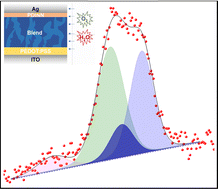In situ near-ambient pressure X-ray photoelectron spectroscopy reveals the effects of water, oxygen and light on the stability of PM6:Y6 photoactive layers†
Abstract
The power conversion efficiency of organic solar cells (OSCs) has taken a further leap in the past three years owing to the emergence of Y6; however, their inferior stability hinders commercialization. Understanding the ambient degradation mechanism of photovoltaic materials is a key component to address this challenge. In this study, we first used in situ near-ambient pressure X-ray photoelectron spectroscopy (NAP-XPS) to investigate the effects of water, oxygen and absorbed photons on the stability of PM6 and Y6. The studied materials PM6 and Y6 show instability to oxygen and water, respectively, possibly due to the weak interaction between PM6 backbone sulphur and oxygen, and Y6 end cyano groups show instability to water. In addition, the stability of Y6 in blended PM6:Y6 films is enhanced, which is confirmed by the performance of OSCs with blended or quasi-bilayer PM6:Y6 photoactive layers. Our findings reveal PM6 and Y6 degradation on ambient exposure and predict a possible way to prevent the degradation of Y6 in OSCs.

- This article is part of the themed collection: Stability of Optoelectronic Materials and Devices


 Please wait while we load your content...
Please wait while we load your content...